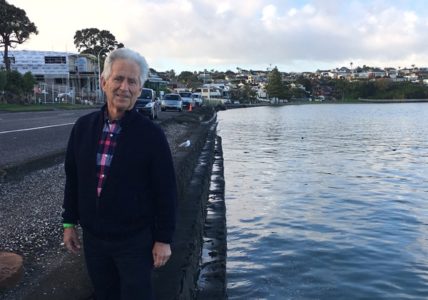
Concern is mounting over continuing delays relating to a restoration project at Bucklands Beach.
More than 200 people gathered earlier this month to show support for the proposed restoration effort at the beach.
There are worries for the sea wall at the northern end of Little Bucklands Beach, as a decision has still not been made to repair the sea wall.
That wall, which was built in the 1950s to protect the road from rough waves, has been identified as structurally unsound and requires major remedial work within the next five years, according to the Annual Shoreline Inspection Report that was released in May.
Former Howick Local Board member Steve Udy says he is disappointed the Board has not yet prioritised repairing the sea wall and included it in its long-term plan.
“I think that the local board needs to grasp the urgency and start to move on this, rather than just drifting with the current,” says Udy, who is working alongside resident and former Olympian Bruce Kendall to provide a solution-based approach to the dilemma.
“Within five years, if we leave the wall as is, it’s going to collapse and take the road down with it. All we are asking is that the board prioritise a seawall resolution,” he says.
“Five years is not a long time, it’s basically only one council term. So this needs to be dealt with now.”
Udy and Kendall have a vision for the Bucklands beach restoration which starts with the northern half of little Bucklands Beach which they believe poses the greatest risk to public safety.
The pair presented their proposed solution to the Howick Local Board on behalf of the Eastern and Bucklands Beach Residents and the Ratepayers Association earlier this year and suggested fixing the sea wall with a bevelled loose stonewall that gives foundations for a footpath and restore the beach by covering the sharp black rocks with sand and shells.
What Udy and Kendall are suggesting is that once the Howick Local Board include the sea wall restoration into their long term plan, they can start pushing for Auckland Council and Auckland Transport to get on board.
“This is going to take more than just the local board funding to fix. What’s going to happen is that it’s probably going to have to come out the council’s environmental budget and that’s going to require Auckland Council itself to get behind it.
“All we want [Auckland Council and Auckland Transport] to do is start putting a couple [of] hundred thousand towards this project each year and that way there will be sufficient funds to get the restoration going,” Udy says.
He believes the board is delaying the solution by taking focus away from the sea wall.
“One of the questions the board is still asking, and I think it’s a valid question, is that why don’t we do Big Bucklands, which experiences flooding several times a year, first?”
“Our position on that is the Big Bucklands’ flooding problem is a far more difficult problem to solve than fixing little Bucklands, and far more costly. Also, we feel it can be managed by knowing that six times a year we are going to have the spring tide,” Udy says.
“The biggest concern with that is water getting into the pipes under the road; however Auckland Transport can manage this without going to the big fix right away. The sea wall on the other hand is going to fall down. You can already put a foot under the road. And we are racing against time to fix it.”
Howick Parks Advisor for Auckland Council, Greer O’Donnell says work has been under way for some time to identify the best management options for Bucklands Beach, but says a coastal management project like this is complex in nature.
“The options available for mitigating further damage to the seawall at Little Bucklands Beach will be considered and a decision on the appropriate coastal management response will be made once further information is available from technical experts,” O’Donnell says.
She says the availability of this information is expected in the coming months, and will ensure the best long-term management option for the area is implemented.
“Both Auckland Council and Auckland Transport are responsible for ensuring that the appropriate coastal management responses are implemented in order to protect the assets impacted and ensure the appropriate level of amenity and service is provided to the public.”










